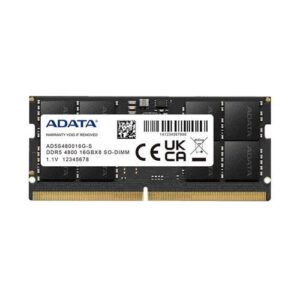RAM
Showing 1–12 of 80 results
How to Choose the Right RAM for Your Needs
Selecting the right RAM (Random Access Memory) is essential for achieving optimal performance in your system. Whether you’re building a PC for gaming, content creation, or general use, here’s a breakdown of the key factors to consider:
1. RAM Size (Capacity)
The amount of RAM you need depends on the type of tasks you perform:
- 8GB: Suitable for light tasks such as web browsing, office work, and light gaming.
- 16GB: Ideal for multitasking, gaming, and moderate content creation.
- 32GB or More: Best for professional workloads like video editing, 3D rendering, or running virtual machines.
2. RAM Speed (Frequency)
RAM speed impacts how quickly data is accessed and transferred:
- 2133MHz – 2666MHz: Standard speeds for basic tasks and older systems.
- 3000MHz – 3600MHz: Good for gaming, everyday use, and mid-range workloads.
- 4000MHz or Higher: Ideal for performance-heavy tasks like overclocking, high-end gaming, and content creation.
3. CAS Latency (CL)
CAS Latency refers to the delay between accessing data and its delivery. Lower numbers indicate faster response times.
- CL16: Common for mainstream RAM, balancing performance and cost.
- CL14 or Lower: Offers better performance, but typically more expensive.
4. Number of RAM Modules
The configuration of your RAM can affect system performance:
- Single Channel: One stick of RAM, which is fine for basic tasks but limits performance.
- Dual Channel: Two sticks of RAM for better performance, ideal for gaming and multitasking.
- Quad Channel or More: Often used in high-end workstations or server systems for maximum bandwidth.
5. RAM Type (DDR Generation)
There are different generations of RAM, each offering improved speeds and efficiency:
- DDR4: The most common and widely used type, providing a good balance between price and performance.
- DDR5: The latest generation, offering faster speeds and higher capacities, but at a higher price point. Great for future-proofing and demanding tasks.
6. Compatibility
Make sure your RAM is compatible with your motherboard and CPU:
- Motherboard Support: Check the maximum supported RAM capacity and speed on your motherboard’s specifications.
- CPU Compatibility: Ensure your CPU supports the RAM speed you’re selecting. For example, Intel’s latest processors support high-speed DDR4 and DDR5 RAM, but older CPUs may be limited.
7. Budget and Brand
When choosing RAM, consider your budget and opt for a reliable brand. Popular and trusted brands include Corsair, G.Skill, Kingston, and Crucial. Higher-end brands may come with extra features like RGB lighting, better heat dissipation, and lifetime warranties.
8. Overclocking Potential
If you plan to overclock your system, opt for RAM that is specifically designed for overclocking (often labeled as “OC” or “XMP”) and comes with a higher speed and lower latency. However, keep in mind that overclocking can require additional cooling and stability adjustments.










